|
|
|
Sort Order |
|
|
|
Items / Page
|
|
|
|
|
|
|
| Srl | Item |
| 1 |
ID:
178334
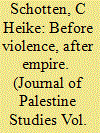

|
|
|
|
|
| Summary/Abstract |
Ariella Aïsha Azoulay’s new book, Potential History: Unlearning Imperialism, offers a rethinking of violence and modernity that presents collaborative, reparative forms of world building as the only viable means of resisting and overcoming the ravages of imperialism. The book is at once a reckoning with empire, a semiautobiographical theorization of complicity, and a magnificent analytic exposé of imperial technologies of knowing, including photography, art, archives and museums, history, sovereignty, and human rights.
|
|
|
|
|
|
|
|
|
|
|
|
|
|
|
|
| 2 |
ID:
178333
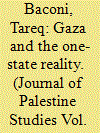

|
|
|
|
|
| Summary/Abstract |
In contemporary conversations around Israel/Palestine, the Gaza Strip is construed as a state of exception, rendering the territory either hypervisible or entirely invisible. Through the prism of the Covid-19 pandemic and Israel’s possible de jure annexation of portions of the West Bank, this piece argues that rather than being exceptional, the Gaza Strip represents the very embodiment of Israeli settler colonialism in Palestine. Its isolation and de-development constitute the endpoint of Israel’s policies of land theft and Palestinian dispossession. This endpoint, referred to as Gazafication, entails the confinement of Palestinians to urban enclaves entirely surrounded by Israel or Israeli-controlled territory. The Trump plan, otherwise known as the “deal of the century,” along with the Covid-19 crisis, have inadvertently exposed the reality of Gaza as an enclave of the one-state paradigm.
|
|
|
|
|
|
|
|
|
|
|
|
|
|
|
|
| 3 |
ID:
178335
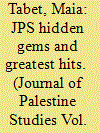

|
|
|
|
|
| Summary/Abstract |
In 1971, the Journal of Palestine Studies (JPS) came into being. Published by the Beirut-based Institute for Palestine Studies, it soon became the organization’s flagship English-language publication, a forum for the study of Palestine and the Palestinians, as well as a repository of documentation on Palestinian life, both past and present. Over the half century that has since elapsed, JPS has been a driver of knowledge production on the Palestinian condition and a crucible of learning.
|
|
|
|
|
|
|
|
|
|
|
|
|
|
|
|
| 4 |
ID:
178336
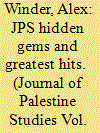

|
|
|
|
|
| Summary/Abstract |
Perusing JPS’s fifty years of documenting Palestinian history, this essay reminds us that history is both “what happened” as well as “the narration of what happened.” Anchoring his selection in that perspective, Alex Winder identifies Charles Anderson’s “State Formation from Below and the Great Revolt in Palestine” (2017) as a JPS “hidden gem,” and Tarif Khalidi’s “Palestinian Historiography: 1900–1948” (1981) as a “greatest hit.” Relying on primary sources by participants in the rebellion and highlighting the history of the revolt, Anderson shifts the focus of traditional accounts of the revolt from the mostly ineffective role of Palestinian notables and elites to the successes of the rebels. In a similar vein, Khalidi’s article paints a picture of a rich and vibrant Palestinian intellectual life in the first half of the twentieth century that reverses the conventional view of the colonized as reactive and of the colonizer as the primary agent of history.
|
|
|
|
|
|
|
|
|
|
|
|
|
|
|
|
| 5 |
ID:
178337
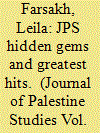

|
|
|
|
|
| Summary/Abstract |
Examining the Journal’s fifty-year trajectory documenting the political economy of Palestine and of the Palestinians (not one and the same), author Leila Farsakh highlights contributions by a rich mix of economists, anthropologists, and other scholars: from Yusif and Rosemary Sayigh, Sara Roy, George Abed, Raja Khalidi, and Linda Tabar to Darryl Li, Judith Gabriel, Nicholas Pelham, Sobhi Samour, Omar Jabari Salamanca, and Helga Tawil-Souri (to name only some). Taken together, Farsakh argues, their writings expose “the diversity of Palestinian economic realities,” and highlight the continuing relevance of the settler-colonial paradigm as “the most useful analytic for understanding the Palestinian economic predicament.” Far from being a neutral technocratic process, economic development is “embedded in power structures that need to be dissected and understood at both macro and micro levels.”
|
|
|
|
|
|
|
|
|
|
|
|
|
|
|
|
| 6 |
ID:
178338


|
|
|
|
|
| Summary/Abstract |
This essay examines JPS’s fifty-year archive of law-related content from the prism of its contribution to the author’s own thinking (and writing) about the relationship between law and politics in the context of the Palestinian question. Noura Erakat identifies as a “greatest hit” Hanna Dib Nakkara’s “Israeli Land Seizure under Various Defense and Emergency Regulations” (1985) for its meticulous documentation of the Israeli legal regime established to confiscate Palestinian lands. Erakat’s “hidden gem” is “Juridical Characteristics of Palestinian Resistance: An Appraisal in Law,” coauthored by W. T. Jr. and S. V. Mallison. Published in 1973, the article argues for the treatment of captured fedayeen as prisoners of war four years prior to the amendment of the Geneva Convention recognizing national liberation struggles as international conflicts.
|
|
|
|
|
|
|
|
|
|
|
|
|
|
|
|
| 7 |
ID:
178339
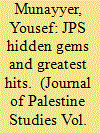

|
|
|
|
|
| Summary/Abstract |
In this essay, Yousef Munayyer reflects on the politics of contentiousness through the lens of dissent and repression. He singles out Naseer Aruri’s “Resistance and Repression: Political Prisoners in Israeli Occupied Territories” (1979) as a JPS “hidden gem” and Gene Sharp’s “Intifadah and Nonviolent Struggle” (1989) as a “greatest hit.” Aruri’s piece, which has not garnered as much visibility as Sharp’s, pinpoints the ways in which political imprisonment, torture, and the weaponization of the law, as well as extraterritorial jurisdiction, are wielded by Israel as instruments of political repression. The “greatest hit,” by the late contemporary theorist of nonviolence Gene Sharp examines the Palestinian national movement’s resistance strategy eighteen months into the First Intifada.
|
|
|
|
|
|
|
|
|
|
|
|
|
|
|
|
| 8 |
ID:
178332
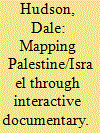

|
|
|
|
|
| Summary/Abstract |
Available on publicly accessible websites, interactive documentaries are typically free to use, allowing audiences to navigate through amounts of information too large for standard film or television documentaries. Media literacy, however, is needed to understand the ways that interactive documentaries reveal or conceal their power to narrate. Examining ARTE France’s Gaza Sderot (2008–9), Zochrot’s iNakba (2014), and Dorit Naaman’s Jerusalem, We Are Here (2016), this article discusses documentaries that prompt audiences to reflect upon asymmetries in the power to forget history and the responsibility to remember it by mapping Palestinian geographies that have been rendered invisible. Since media ecologies are increasingly militarized, particularly in Palestine/Israel, interactive documentaries like iNakba and Jerusalem, We Are Here can disrupt Israeli state branding as technologically innovative while minimizing risk of surveillance by avoiding the use of location-aware technologies that transform interaction into tracking.
|
|
|
|
|
|
|
|
|
|
|
|
|
|
|
|
| 9 |
ID:
178331
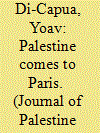

|
|
|
|
|
| Summary/Abstract |
In the early 1960s, Israeli diplomats based in Paris noted that student life there had become political in new ways that threatened to undermine Israel’s image and standing in the public mind. In an effort to understand the growing international student body and its nine thousand well-integrated Arab students, the embassy asked Israeli students to spy on their colleagues and submit detailed reports about their political associations, thoughts, opinions, connections, whereabouts, and much else. Using the reports and other auxiliary material that the Israeli diplomats collected, this article examines the formation process of a unique, student-led intellectual and political ecosystem. Specifically, it shows how, in tandem with the rise of the New Arab Left and other transnational student collaborations, the Palestinian question grew from a marginal and marginalized issue to a major cause that was deeply entwined with other contemporaneous causes of universal resonance, such as those of South Africa, Rhodesia, and Algeria.
|
|
|
|
|
|
|
|
|
|
|
|
|
|
|
|
| 10 |
ID:
178330
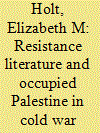

|
|
|
|
|
| Summary/Abstract |
For the last decade of his life, the Palestinian intellectual, author, and editor Ghassan Kanafani (d. 1972) was deeply immersed in theorizing, lecturing, and publishing on Palestinian resistance literature from Beirut. A refugee of the 1948 war, Kanafani presented his theory of resistance literature and the notion of “cultural siege” at the March 1967 Beirut conference of the Soviet-funded Afro-Asian Writers Association (AAWA). Articulated in resistance to Zionist propaganda literature and in solidarity with Marxist-Leninist revolutionary struggles in the Third World, Kanafani was inspired by Maxim Gorky, William Faulkner, and Mao Zedong alike. In books, essays, and lectures, Kanafani argued that Zionist propaganda literature served as a “weapon” in the war against Palestine, returning repeatedly to Arthur Koestler’s 1946 Thieves in the Night. Better known for his critique of Stalinism in Darkness at Noon (1940), Koestler was also actively involved in waging cultural Cold War, writing the United States Central Intelligence Agency’s (CIA) Congress for Cultural Freedom 1950 manifesto and helping the organization infiltrate Afro-Asian writing in the wake of Bandung. Kanafani’s 1960s theory of resistance literature thus responded at once to the psychological dislocation of Zionist propaganda fiction and the cultural infiltration of Arabic literature in the Cold War.
|
|
|
|
|
|
|
|
|
|
|
|
|
|
|
|
|
|
|
|
|